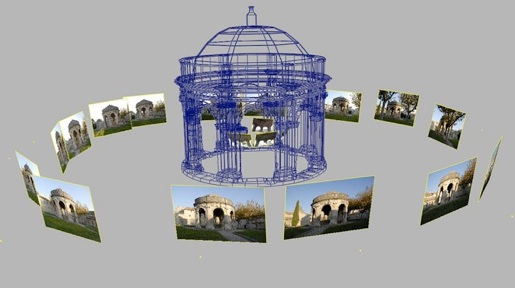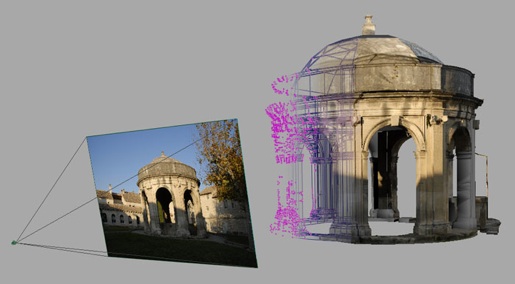
Taking photographs
It is necessary to take pictures around the object so as to cover it completely. Nevertheless, the symmetry of the object that if one is the axis of an arch, we see the ark without opposing views on the pillars exact opposite (for reconstruction). To protect against this problem, two photographs were taken right and left of the axis of each arch in order to have the shots on two pillars objected example, 14 images were taken (2 per arch). Eight shots were made inside the fountain, each backed by pillars, pointing to the vault and the top three pillars that face photgraphiy .

Camera calibration
The external environment of this fountain has been widely used . The fact that the fountain is in an enclosed space (cloister) provides a multitude of obvious reference points (corner of the wall, window …). This provides the first eight points for calibration, evenly distributed in the picture. Few corners of the fountain were used for calibration because they are all corrupted and therefore little or no specific. Those are used rather imperfections characteristics of the stone and small holes recognizable. Interior pictures were calibrated using the points visible on the pillars. The reference Z was raised along a pillar in order to define the vertical model. The benchmarks X and Y have little significance because the fountain is not geometrically orthogonal but octagonal. As a result, the angles of 90 ° will not be useful for modeling.

Modeling
Since the pillars are distributed around an axis of rotation, it seems necessary to define it first. The items used are the amounts of pillars; it took three to define the points of attachment of a circle. From there, the circle was positioned at capitals so it is extruded vertically to the top of the rotunda. The pillars are the same, one to be enough for the other seven. It was necessary to use the pillar angles with the least damaged so as to facilitate modeling.

Thereafter and after duplication around the axis defined previously, they were modified on a case by deteriorating elements as they are in reality, including corners and edges that are often broken. The circle before allowing us to make the party overlooking the capitals was extruded to the bottom arches. Thus, the creation of arcs is by removal of material that allows us to have a homogeneous geometry, and construction of arc in each case.

Mesuring
After taking some measurements in situ, it is enough to integrate them into the model to whether to scale. Thus, the degree of accuracy is estimated at 1 millimeter per meter.

Texturing
Photographs used for texturing a mesh are those who are most parallel to it. Thus, these textures are extracted very best (details, color, …).

Florian Moreno - Avril 2009 - Portal of Architectural Image-Based Modeling
Photomodeling of the fountain in the Saint-Jean Cloister
Chartreuse of Villeneuve lès Avignons in France
Florian Moreno
flomoa@hotmail.com

It was necessary, before taking photographs, to understand the volume, distribution of elements and redundant facilities / difficulties of access to the fountain. This fountain is an octagonal rotunda plane. There are eight pillars evenly spread around the central axis of Rontondes. Access: space around the fountain is free. Only two trees near the fountain partially hide the view.
